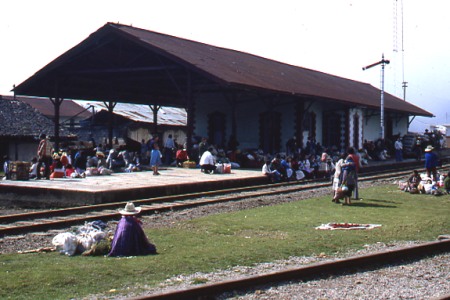In earlier posts, we’ve taken a quick look at typical Spanish-language place names (toponyms) and also some common indigenous place name elements. But what about those place names that do not match any of the expected categories?
My personal favorites in this category include the railway stations of Honey in the state of Puebla (named for a famous railroad engineer) and Wadley in the state of San Luis Potosí. The latter is particularly strange since the letter w does not belong to the Spanish alphabet. I’ve never been able to identify the origin of the name Wadley with any certainty, but for one possible explanation, see Mexico has many “Est”raordinary railway places.
Another example of an unusual name is that given to one of the sharpest curves on the Mexico City to Cuernavaca highway — La Curva de la Pera, which means “The Curve of the Pear”. The derivation of this name for a bend in the road that loops back on itself is fairly self-evident. Here’s hoping that your vacation after navigating past this bend does not end up being similarly “pear-shaped”!
Many similar instances of how names were allocated, and examples where place names proved critical to legal issues, are given in Raymond Craib’s excellent “Cartographic Mexico, a history of state fixations and fugitive landscapes” (Duke University Press, 2004). This is a perceptive study of the relationships between history and geography in Mexico from the mid-19th century until about 1930. Craib emphasizes the significance of map-making in post-Independent Mexico as a means towards furthering nationalism and as a development tool. He also traces the changing motives of map-makers, focusing especially on the key area of Veracruz-Puebla which served as Mexico’s main gateway to Europe for centuries. One case study examines a mining area where the granting of water rights hinged on precisely where a particular river flowed, and which tributary was which. This proved to be a case where cartographic ‘proof’ was impossible to find, and a pragmatic solution was required.
For a more complete explanation of some of Mexico’s place names, see “Mexico’s place names and their meanings” on MexConnect.
5 Responses to “Unusual place names in Mexico”
Sorry, the comment form is closed at this time.


I have a hunch that Wadley, Mexico, or Estacion Wadley, got its name the same way several towns in the southern U.S. did. The Wadley family, of which I’m a descendent, built railroads.
The head of the family, William Morrill Wadley, a blacksmith by trade, came to Savannah from New Hampshire in the mid-1800s and gradually became a railroad builder. He served briefly as commissioner of railroads for the Confederacy, but quit, and after the Civil War became involved in reconstructing the rail system in the south. One of his daughters married William Greene Raoul, also a railroad man. Below is an excerpt I discovered in an application to include his grandson’s home in Asheville, NC, in the National Register of Historic Places. As you can see, the Wadley railroad influence extended even into Mexico.
Thomas Wadley Raoul’s grandfather, William Wadley, first achieved prominence as head of railroads for the Confederacy during the Civil War, experience that Wadley and his son-in-law William Greene Raoul turned to fortune during Reconstruction as organizers of the Central of Georgia Railroad. In 1886, William Raoul became chief executive of the Mexican National Railroad Company which a group of investors, mostly Englishmen, had organized to salvage a bankrupt attempt to build a rail line from Laredo, Texas, to Mexico City. He would later extend the line to Veracruz.
Yours truly,
Thom Smith
Boca Raton, FL
Thank you so much for sharing this information with me. You are undoubtedly correct that the name of the station, like so many others in Mexico, comes from the name of one of the builders or engineers. I’m thrilled that you’ve taken the trouble to write and explain your family connection to Wadley. The choice of such an unusual name (in terms of Spanish language placenames) now makes perfect sense. Thanks!!
I’ve just decided to start figuring out where I come from. I’m of Mexican descent and my grandfather told me he grew up in this puebla. It’s fascinating to see that there is a tiny bit of information about this town. He did mention that it was named after an American that moved down there. I wasn’t sure of the specifics. He’s always said he wanted to take us down to see it. Maybe one day I’ll trek down there just to see where my grandpa grew up. 🙂
I think you should do that, and then you can provide us with an update about the community of Wadley!
my father and mother(both deceased) were from there [Wadley] not sure if they were born there.
I would like more information. where can I start?